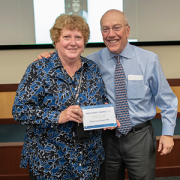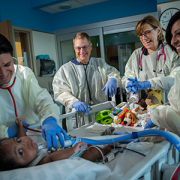Patient-centered family conferences can boost satisfaction with care

A research team led by Tessie W. October, MD, MPH, a critical care specialist at Children’s National Health System, sought to clarify the association between the patient-centered nature of physicians’ communication patterns and the degree to which parents were satisfied with decision-making during family conferences in the PICU. In order to dissect the dynamics of those conversations, the team recorded 39 family conferences, which averaged 45 minutes in length. The medical team spoke 73 percent of the time. Physicians contributed 89 percent of the dialogue and spent 79 percent of their time speaking about medically focused topics. Parents’ contribution amounted to 27 percent of the conversation, according to the study, “Parent Satisfaction With Communication is Associated With Physician’s Patient-Centered Communication Patterns During Family Conferences.”
“These conferences cover some of the toughest decisions that families of critically ill children will ever make: Whether to start life support, place a tracheostomy, repeat bone marrow transplantation, or to withdraw life-sustaining interventions,” Dr. October says. “Rather than essential decisions about the child’s care being made in partnership with families, the conferences are akin to monologues with the medical team deciding the pace and content of the conversation.”
A few subtle changes can shift more of the balance of the conversation to the parents and, when clinicians use these skills, parents are more satisfied with the decision-making, she says. Simple changes include maintaining eye contact, smiling when appropriate, and acknowledging the parents’ emotions by saying “I can’t imagine how difficult this must be for you” or “I wish I had better news” – rather than simply informing the parents of the child’s prognosis. When these social niceties are skipped, parents can perceive their medical team to be uncaring, she says. Slowing the pace of the conversation is helpful, as are including open-ended questions and moments of silence, which both tease out opportunities for parents and family members to offer their thoughts.
“There is an art to it,” October says. “From the outset, clinicians can ask about the family’s understanding of their child’s medical condition and follow up with questions about their family’s goals, such as ‘What does a meaningful life look like? Has anyone ever spoken with you about that?’ ”
The parents who were involved in the study completed satisfaction surveys within 24 hours of the family conference. “The median parent satisfaction score was significantly higher (82.5) when the patient-centeredness score was greater than or equal to 0.75, compared to a median satisfaction score of 70.0 when the patient-centeredness score was less than 0.75,” October and co-authors write.
“We do not know the optimal balance of discussing psychosocial elements compared to medical talk, but our results reveal that the amount of psychosocial elements does impact[the degree of parent satisfaction with communication. It is clear that parents want their fears and concerns to be understood and addressed, and they want to feel cared for and about. Making our interactions with parents more patient-centered can likely improve the communication experience for parents and also improve the grieving process should their child not survive their illness,” the authors continue.
In the next phase of research, the team will explore how parents’ perceptions change when additional members of the medical team speak during family conferences. In the current study, case managers and bedside nurses each spoke 2 percent of the time while social workers spoke 7 percent of the time.
Related Resources: Patient centered family conferences can boost satisfaction with pediatric ICU care










